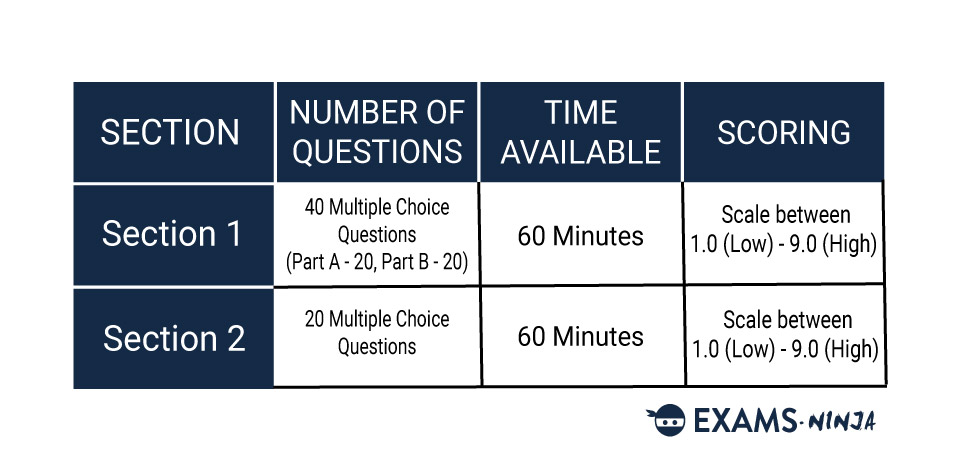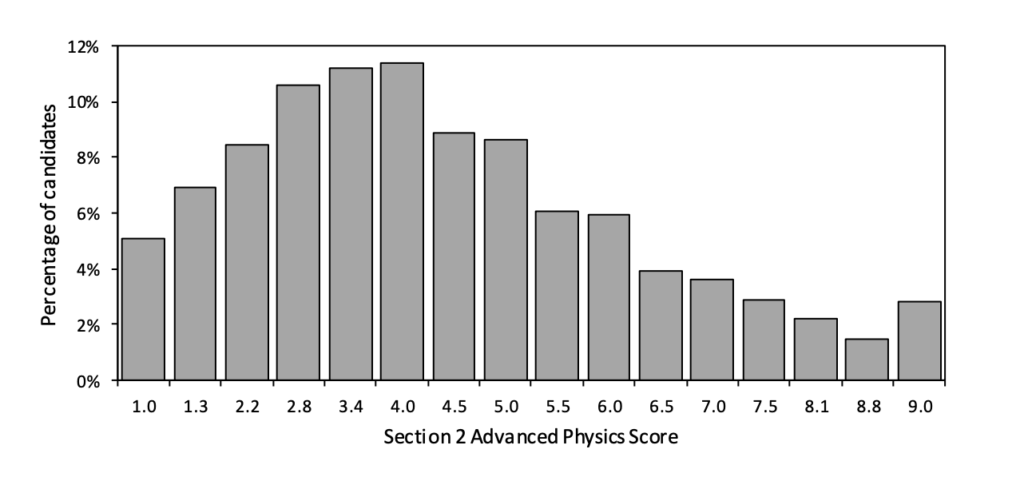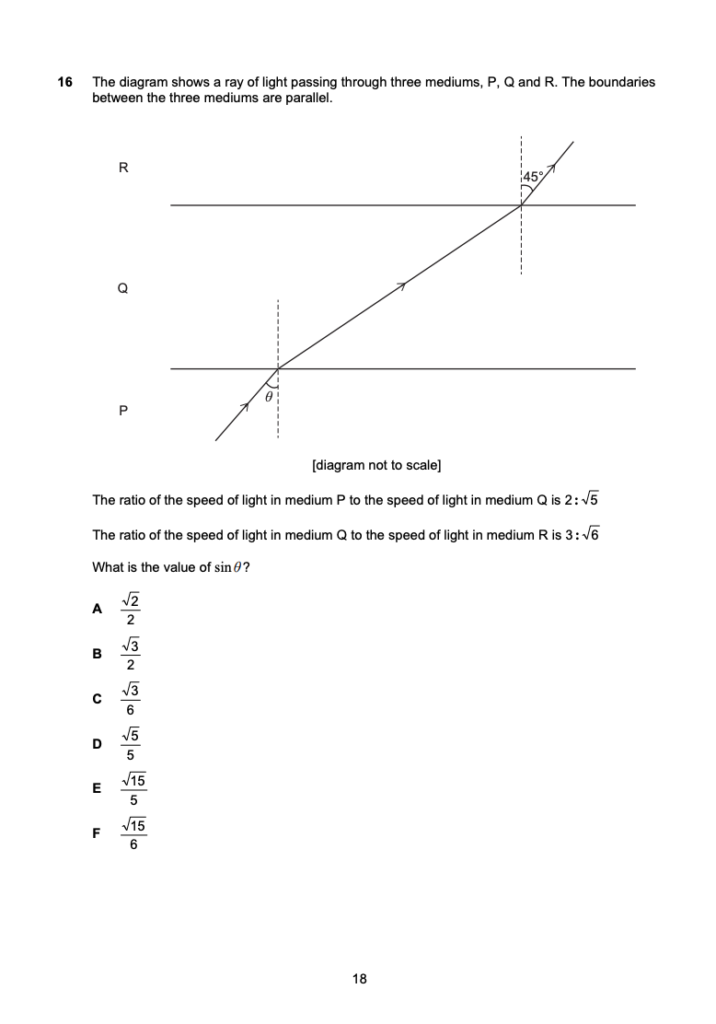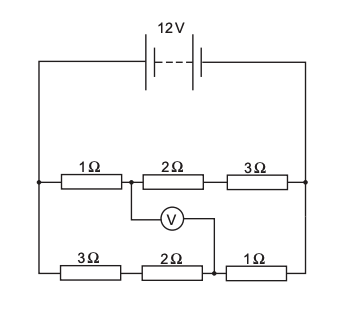ENGAA GUIDE
ENGAA Section 2: The Definitive Guide to ENGAA Advanced Physics
Written by: Matt Amalfitano-Stroud
Please be aware that, as of 2024, the Engineering Admissions Assessment (ENGAA) is no longer being used by the University of Cambridge. Cambridge applicants for Natural Sciences, Engineering, Veterinary Medicine and Chemical Engineering & Biotechnology will be required to sit the Engineering and Science Admissions Test (ESAT).
So, you’ve made it through 40 of the toughest questions you’ve faced in your education so far. What comes next? 20 more questions about Advanced Physics of course! With this guide, we’ll show you what you need to know for Section 2 of the ENGAA and how you can get a great score!
1/5
BASICS OF THE ENGAA
You should hopefully know how the ENGAA works at this stage of your preparation, but let’s just quickly go over it to refresh your memory.


What is the ENGAA?
The Engineering Admissions Assessment (ENGAA) is the admissions assessment for all applicants of Engineering and Chemical Engineering at the University of Cambridge. The ENGAA is a pre-interview assessment and in 2023, it will be sat on October 18th, which is a few weeks earlier than in previous years. Thankfully, there isn’t a fee attached to the ENGAA, so it’s completely free.
There are 2 main sections in the ENGAA, Section 1 and Section 2. Section 1 consists of two subsections, Section 1A and Section 1B. This section contains 40 questions and covers both the core topics and advanced topics of maths and physics.
Section 2 is all about Advanced Physics. You’ll need to answer 20 tougher questions in 60 minutes. We say it’s all about physics, but you’re still going to need to retain all your knowledge of maths in order to answer the questions!
Section 2 sounds a fair bit easier than Section 1 at first glance, being more of the same but half as much! Don’t be fooled though, these questions will be the toughest in the exam. It is stated that the questions in Section B will require a more creative thought process and greater problem-solving skills to answer these questions effectively. If you don’t believe us, try out some questions for yourself!
Here’s a summary of the ENGAA format:
ENGAA Test Format
How is the ENGAA Scored?
The scoring in the ENGAA is fairly simple. Each section (including each part of Section 1) is scored on a scale between 1.0 (low) and 9.0 (high) which is converted from your raw marks based on your correct answers. Here we can see the Score Distribution for Section 2 of the ENGAA in the 2021 admissions cycle.
ENGAA Section 2 Score Distribution (2021)
Every exam’s score distribution chart will show you the scoring trends for that particular paper. For Section 2 of the ENGAA, you can see that the most common score achieved was 4.0, with a pretty large drop off of applicants achieving 4.5 and above.
Therefore, it would be safe to assume that the chances of receiving an offer were much greater amongst the students that achieved above 4.5 on the test.
There’s plenty more that you can learn about the ENGAA, so check out our Definitive ENGAA Guide.
Recharge your Advanced Physics Knowledge with Exams.Ninja!
Our ENGAA Preparation Programme gives you everything you need to prepare for Section 2 of the exam. You’ll have instant access to 100+ tutorials and 900+ practice questions, all available from your home! Start your journey now with your free demo!
2/5
WHAT TO EXPECT FROM THE ENGAA SECTION 1B
At first glance, Section 2 of the ENGAA may seem pretty similar to Section 1. Layout wise, it is! But there’s more to these questions than first meets the eye.
As we’ve already spoken about before in previous section guides, the ENGAA is a fairly simple exam, format-wise. There are no essays to write, no long-form answers, just 60 simple multiple-choice questions. That’s not to say that the content of these questions is simple, but in terms of format, it doesn’t get much easier.
Sections 1A and 1B are laid out pretty much identically, and Section 2 isn’t that much different. Let’s take a look at what a typical page will look like:
ENGAA Section B Example Page
The question format here is basically the same as what you would’ve seen in the previous section. Your questions are numbered 1-20, while your answer options are labelled A- H depending on how many are available (there will always be at least 5).
Where does Section 2 differ though? The biggest change you’ll find is that every page is dedicated to a single question. There are two reasons for this. Due to the complexity of some of the Section 2 questions, they will take up much more space on the page. There will be plenty of diagrams and graphs in this section that you’re going to need to work with.
But what if the question doesn’t have large imagery? Why is there all this extra space?
Simply put, you’re going to need it. As we’ve already stated, Section 2 of the ENGAA requires a more creative approach to your problem-solving. These questions are going to require experimentation and experimentation requires space. Therefore, more blank space on the page is made available for your rough work.
As always, you’re not allowed calculators, spare paper or any other additional resources, so using this space is going to be vital to your success. Even if your mental arithmetic is really good, you’re going to find something that you just have to write down when answering these questions!
Exams.Ninja Tip
Although it’s not specifically referenced in the ENGAA Specification, we would recommend you practice your calculus when revising. It’s an area of maths that becomes extremely helpful when you don’t have access to a calculator, as it will save you time and effort compared to other methods of calculation.
If calculus is a weaker topic for you, then our Guide to PAT Calculus will be extremely helpful for you. The PAT and ENGAA have very similar questions, so the skills from one exam will easily transfer to the other.
3/5
ESSENTIAL INFORMATION FOR ENGAA SECTION 2
Section B is all about physics, so you’re going to need to brush up on all of your physics knowledge, from your mechanics to your materials!


First things first, let’s go over scientific quantities and units (SI-units). Many questions within the ENGAA will be using these in some form, so you’re going to need to understand how they work in order to stand a chance of answering the questions! Makes sure you memorise these SI-prefixes before you enter the exam:
SI- Prefixes/Units
nano- 10–9
micro- 10–6
milli- 10–3
centi- 10–2
deci- 10–1
kilo- 103
mega- 106
giga- 109
As well as this, you’ll need to make sure you understand the use of negative indices in units (such as ms-1 in velocity)
Exams.Ninja Tip
These units can be pretty easy to forget, especially when you’re under exam pressure, so how can you keep this information in the back of your mind? Posters of course (the answer to everything)! Keep a small poster somewhere you’ll see it every day, or even a post-it note if you’re short on space. After seeing it enough times, this will all be ingrained into your brain!
ENGAA Section 2 Syllabus
Now it’s time to take a look at exactly what it is the ENGAA requires you to know. While everything in the specification won’t be covered in a single paper (there are only 60 questions after all), you still need to revise everything included as you don’t know what will turn up when you go to sit the exam.
Section 2 assumes a knowledge of the standard Mathematics and Physics that were required in ENGAA Section 1A, so we’ll just quickly refresh our memory of what we need to know.
Mathematics
Although Section 2 of the ENGAA doesn’t involve any pure maths questions, these basic principles of mathematics are essential for all areas of the ENGAA and beyond:
- Units and Convertions
- Number Operations
- Ratio and Proportion
- Algebra
- Geometry
- Statistics
- Probability
Physics
Before you can begin to revise Advanced Physics, you need to make sure you understand all of the following topics to a standard level of competence:
- Electricity
- Magnetism
- Mechanics (Kinematics and Forces)
- Thermal Physics
- Matter
- Waves
- Radioactivity
Ideally, you should have a pretty good understanding of all that by now. You’re definitely going to need it as we’re now looking at Advanced Physics!
The required knowledge here is the same as the Advanced Physics required for Section 1B, minus the Advanced Mathematics (although you’re still going to be using these principles in the questions, they’ll just be in the context of physics). However, as we’ve already seen, Section B will be taking this knowledge work a step further by asking you to work creatively and find solutions using less familiar methods. Let’s refresh our memory of everything you’ll need to know:
Forces and Equilibrium
A major part of all physics, you’re going to want to know this topic inside and out! Your revision should include:
- The nature of scalars.
- The nature, components and resultants of vectors, including coplanar vectors.
- Moments, including those defined as force x perpendicular distance from the point to the line of action of the force.
- Normal and frictional components of contact forces.
- The terms “smooth” and “rough” in the context of physics.
- The concept of “centre of gravity”.
- Solving problems that involve the equilibrium of rigid bodies under coplanar forces.
Kinematics
Kinematics is defined as the branch of mechanics that is concerned with the movement of objects without reference to any relating forces. It’s a very technical topic, so be sure to revise the following:
- The equation “power = force x velocity”.
- The equations of motion; “v = u + at”, “s = ut + (1/2)at2”, “s = (u + v)t/2” and “v2 = u2 + 2as”.
- The use of graphical methods involving acceleration, displacement, distance, speed, time and velocity.
- The use of graphical representations of one-dimensional motion.
Newton’s Laws
You should hopefully be aware of these three essential rules of mechanics, but here’s a little reminder:
- An object will not change motion unless a force acts on it.
- The force of an object is equal to its mass multiplied by its acceleration.
- When two objects interact, they apply forces to each other in opposite directions and of equal magnitude.
However, it’s about more than knowing these rules; it’s about the application of them as well. Be sure. to revise the following:
- Application to linear motion of point masses moving under the action of forces.
- Solving problems that involve projectile motion.
- Solving simple problems that involve two bodies connected by a light inextensible string or rod.
- Modelling bodies moving vertically with constant acceleration.
Momentum
This one’s a major part of mechanics, so you’ll want to treat this as its own separate topic. To start off, you need to know the equation for momentum, p = mv. From there, you’re going to need to revise the following:
- Linear momentum.
- The principle of conservation of momentum in the 1st dimension.
- The relation of conservation of momentum to Newton’s laws of motion.
- Application of the equation “impulse = F∆t”.
Energy
Everything you do, including your revision, requires energy, so you can be sure you’re going to need to understand it when taking the ENGAA. The following topics are specified in the ENGAA syllabus:
- Use of the equations “∆Ep = mg∆h” (gravitational potential energy) and “Ek = 1/2 mv2” (kinetic energy).
- Use of the principle of conservation of energy, including quantitative and qualitative use of energy conservation.
- Application of the equations “power = rate of doing work = rate of energy transfer” and “efficiency = (useful energy transfer/total energy input) x 100%”.
Materials
All physical matter is covered under material physics, but it’s not too difficult once you’ve studied the core elements of the topic. For the ENGAA, be sure to revise the following:
- Application of the equations “density = mass/volume”, “young modulus = stress/strain" and “pressure = normal force/area”.
- The concepts of tensile and compressive deformation in elastic and plastic.
- Application of Hooke’s law, including the equation spring constant = force per unit extension.
- The behaviour of springs, including loads, extension and elastic limit.
- The concept of strain energy.
- Definitions of the terms “stress”, “strain” and “ultimate tensile strength”.
Waves
Waves are covered in the standard physics syllabus as well, but Section 2 will be testing your knowledge of the topic even further. There’s plenty of equations and terms to understand, so be sure to revise the following:
- Describing wave motion when illustrated by strong, ropes and ripple tanks.
- Use of the equations “frequency = 1/period”, “speed = frequency x wavelength” and n = 1/sinC.
- Identification of nodes and antinodes.
- The principle of superposition.
- The comparison of transverse and longitudinal waves.
- The concepts of reflection/refraction of waves, total internal reflections and critical angle (C).
- Definitions of the terms “amplitude”, “displacement”, “frequency”, “path difference”, “phase difference”, “period”, “speed” and “wavelength”.
Electricity
Lastly is electricity, one of the topics you’ll likely have been learning about since primary school! The ENGAA will be testing you on the most complex principles of electricity you’ll have seen so far, so this one is going to require plenty of revision, including:
- Use of the following equations; “charge = current x time”, “potential difference = work done/change”, “V = IR”, “P = VI”, “P = I2R”, “P = V2/R” and "resistivity = resistance x (cross-sectional area/length)".
- Application of Ohm’s law and Kirchhoff’s laws.
- Recognition and use of standard circuit symbols and diagrams.
- Electromotive force (emf)
Exams.Ninja Tip
Section 2 is going to require you to use lots of equations, so it goes without saying that you’re going to need to know the formulae by heart. Some may be given to you in the paper, but it’s good practice to assume you will be given nothing.
You will hopefully have been taught and retaught all of these already, so it’s just a matter of memorising each one and understanding how they are used. The formulae and equations you’ll need to learn include the Equations of Motion, Electrical Equations and Energy Equations. Essentially, there are at least a couple of equations for each section of the syllabus!
We have a full list of important formulae and equations in our ENGAA Section 1A Guide, so be sure to check them out!
So, that covers everything you’ll need to know for Section B of the ENGAA, at least in terms of actual knowledge. All of this information is also available from the official ENGAA syllabus, which you can check out here.
4/5
TOPS TIPS FOR SECTION B REVISION AND EXAMINATION
Knowing what the test will cover is just the start of your preparation journey. Next, you’re going to need to know how you can best tackle your revision, as well as learn a few techniques for actually sitting the exam. Read on to see our recommendations!
ENGAA Revision Tips
Now you have an understanding of what you need to revise, it’s time to start getting to work on revising in the most effective way possible!
1. Your Revision Plan is Essential
Anyone will tell you this is true! But what is the purpose of a revision plan exactly? It’s exactly what it sounds like! It’s a schedule of when you’re revising, what you’re revising and how long for. The more specific your plan is, the more likely you will be to follow it, especially if you include plenty of short breaks and manageable session lengths. We would even recommend you create a 6-Month Preparation Timeline to make sure you’ve got enough time to cover everything!
What’s the benefit of this though? The rewards you’ll get from putting the effort in at the start are more long-term than short-term. To start with, you won’t be wasting time trying to figure out what you need to be doing. It will also give you a headstart when you begin each revision session, which will increase your motivation to start and restart after any scheduled breaks.
Lastly, it will remove a lot of stress from the revision process as you won’t need to second guess yourself that you’re revising the right thing, all of that planning will have ensured that you are!
2. Identify your Strengths and Weaknesses
When creating your plan, how can you know what you should be revising at each point? The best way to go about this is by singling out your weakest subjects. These are the subjects that will require the most effort to revise.
When working on your weaker subjects, you’re going to want to include additional time in your plan to account for the additional work that will be required to perfect your knowledge. If you still don’t get it after you’ve used all your allocated time, that’s alright. You may have a gap in your schedule to spend some extra time, or you may have a revision session planned for something that you’re already very confident with.
Remember though, your revision should cover everything, not just the subjects you enjoy or the subjects that you struggle with. You don’t need to dedicate an equal amount of time to everything, but you should be sure to refine your knowledge of everything in the specification before you sit the exam.
3. Complete Practice Questions and Papers
This is often considered the most effective revision method. Many people learn better from doing rather than reading, so this is where practice questions and mock exams come in.
It’s the most practical method of revision for any exam, as it gives you first-hand experience of what to expect when you take the actual ENGAA.
Whether you find yourself breezing through every question you find, or you end up stumbling on certain subjects, the time you spent practising will be extremely well spent. And if you are struggling, you should try to seek out questions with worked solutions. These will do wonders for your confidence, as it will either show you where you went wrong and help you correct your mistake, or it will allow you to reaffirm your knowledge if you answered correctly!
Exams.Ninja’s ENGAA Preparation Platform is definitely one of the best places to get practice questions, with over 900 questions to attempt. They cover every section of the exam and every topic in the syllabus.
4. Practice Under Exam Conditions
There are several rules to remember before you take the ENGAA. First of all, you aren’t allowed a calculator for any part of the exam. In fact, you’re not allowed any additional resources outside of what is given to you on the paper. So when you’re practising at home, you should abide by the same rule so you don’t find yourself using any banned resources as a crutch for the exam.
If you get used to using something that’s not allowed, you’ll find yourself panicking when you take the actual exam! If you’re struggling, try to practice your calculus. This will help you big time when you’re trying to solve complex equations by hand.
As we know, the exam allows you just 60 minutes to complete these 20 questions. So if you’re practising with a mock exam or past paper, why not give yourself the same time limit? It’s a great idea to learn how to deal with these time limits before you get to the actual exam! There won’t be any consequences for missing the deadline, but there will still be just enough pressure to motivate you to finish in time.
ENGAA Exam Tips
It’s the big day, and you’ve got the dreaded ENGAA paper in front of you. What do you do? Here are a few tricks to help you avoid freezing in your seat!
1. Give Yourself a Quick Break
When we say this, we don’t mean you should literally walk out for a few minutes! You’ve just finished answering 40 difficult maths and physics questions, so you may need a little recharge before you start attempting even more!
Your approach to this could go several ways. You may want to go through the paper and read all the questions to give yourself a better idea of what you’ve got to do. You may just want to quickly go through and find a question that you find particularly easy before going back to the start (known as low hanging-fruit). Or, you may just want to relax your mind a few moments and not look at the paper at all (we wouldn’t necessarily recommend this but to each their own).
If you’re worried about the time limit, just remember that you’re answering half the amount of questions as Section 1. Granted, these questions are more tricky, but it’s still considerably less, so there’s a little bit more leniency on how you want to approach it.
2. Answer Everything
This one is super important! You do not lose marks for any incorrect answers, so every question in the paper needs to be attempted, no matter how unsure you are of the answer.
If you’re stuck on a question, your first option is to skip it and come back to it later. This is often a good idea, as you’re going to want to attempt every question in the paper. If you have enough time before the end of the exam, then some of that time can be spent attempting the questions you couldn’t get before.
No matter how much time you have though, you are always going to want to put an answer for everything. Even if it’s a random guess, it will still give you a better chance of gaining the mark than leaving it blank. Being multiple-choice, it’s even easier to pick out an answer as all your options are already there for you.
3. Think Outside the Box
Section 2 will be testing you on areas outside your comfort zone when it comes to physics, so you need to be willing to get creative.
The ENGAA specification specifically states that Section 2 will require candidates to use creative thinking, problem-solving and less familiar application of principles. Basically, you should be expecting the unexpected when taking this paper!
Remember, you’ve got lots of space to try out any method that you feel could potentially be a solution to the question. If it doesn’t work out, that’s not a problem. There’s no harm in trying any ideas that may come to you. The only thing to be careful of is the time, you shouldn’t spend too long on any single question in the exam, see the above tip for more information on that.
There’s much more to learn about the ENGAA, Exams.Ninja guides you through everything you need to know!
Whether you want a complete refresher on the ENGAA syllabus or are just looking to take on some past papers, our ENGAA Preparation Platform gives you all the resources you need to become an ENGAA master!
5/5
ENGAA SECTION 2 PRACTICE QUESTIONS
You should hopefully know by now that practising actual questions is the best way to let your revision sink while preparing your exam technique. Here’s a taste of what you can expect from the ENGAA’s questions.
A painter of mass 74 kg stands on a uniform wooden plank of length 2.5 m and of mass 24 kg. The painter stands at the middle of the plank. The plank rests on two supports. Support P is 0.25 m from one end of the plank and support Q is 0.75 m from the other end. A pot of paint of mass 5.0 kg is 0.80m from the centre of mass of the painter.
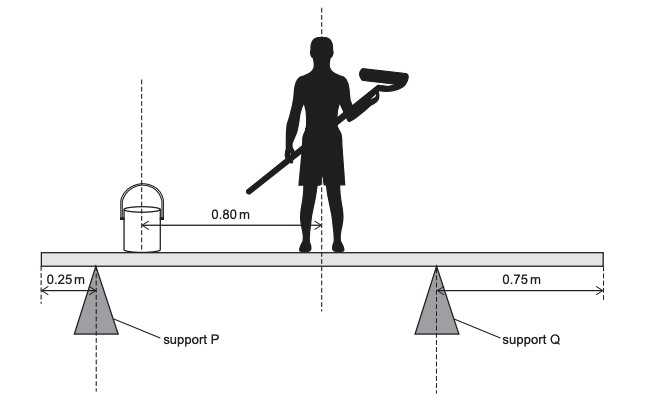

What is the force exerted by support Q on the plank?
(gravitational field strength = 10Nkg–1)
A) 50 N
B) 51.5 N
C) 66 N
D) 177 N
E) 500 N
F) 515 N
G) 660 N
H) 1770 N
The correct answer is E.
Take moments around point P:
0.2 ∗ 5 + 24 ∗ 1 + 74 ∗ 1 = FQ ∗ 1.5 → FQ = 660 N
A block P has a smaller block Q resting on its top surface. Q is connected to a hanging block, R, by a light, inextensible string. The string passes over a smooth pulley which is connected to block P, as shown in the diagram.
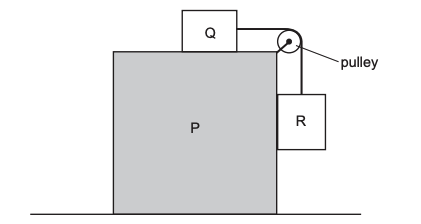

The masses of blocks P, Q and R are mP, mQ and mR respectively. The surfaces of the three blocks are smooth. P is accelerated horizontally to the right by an external force. While this is happening, Q and R do not move relative to P.
What is the acceleration of P?
(gravitational field strength = g)
A) mQg/mR
B) mRg/mQ
C) mRg/(mR + mQ)
D) mQg/(mP + mQ + mR)
E) mRg/(mP + mQ + mR)
F) mQ + mR)g/(mP + mQ + mR)
The correct answer is B.
First calculate the acceleration of body Q, using free-body diagrams for bodies R and Q (do not account for P moving):
T = mQa and mRg – T = mQa → a = mRg/(mR + mQ).
For the bodies Q and R to be still relative to P, while P is moving, the acceleration of P must be in the opposite direction to the above acceleration and equal in magnitude to it.
A tennis ball travelling at a speed of 30 m s–1 hits a racket elastically with a kinetic energy of 27 J. The racket applies a variable force to the tennis ball for a time of 4.0 ms as shown.
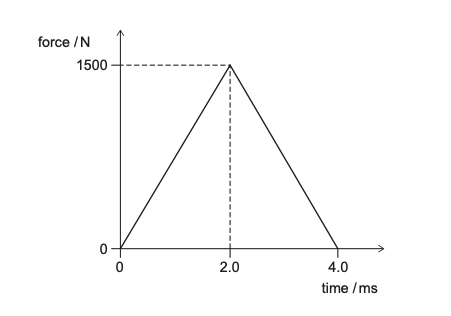

The ball moves away in the opposite direction to its initial motion. With what speed does the ball leave the racket? (Assume that resistive forces are negligible.)
A) 20 ms-1
B) 28 ms-1
C) 32 ms-1
D) 50 ms-1
E) 70 ms-1
F) 80 ms-1
G) 100 ms-1
H) 130 ms-1
The correct answer is A.
The mass of the ball can be calculated from the initial conditions of the kinetic energy:
27 = (m ∗ 30²)/2 → m = 0.06 kg.
Using the definition of impulse:
mΔv = ∫ F dt → 0.06(vfinal + 30) = (1500 ∗ 4 ∗ 100-3) → (vfinal + 30) = 3/0.06 = 50 → vfinal = 20 m/s.
To note, the integral is the area under the graph force-time and for the velocities be careful with the signs.
A man is cycling along a straight horizontal road at a constant speed of 9.00 ms–1 . He passes a boy who is cycling at 5.00 m s–1 in the same direction. When the man is level with the boy, the boy begins to accelerate at a constant rate of 0.800 ms–2. The boy maintains this constant acceleration and the man continues at constant speed until the boy passes the man.
What is the time interval between the two instances when the man and the boy are level?
A) 5.00 s
B) 10.0 s
C) 22.5 s
D) 35.0 s
E) 90.0 s
The correct answer is B.
The distance and time travelled between the meet-ups must be the same for the boy and the man. Applying the SUVAT equation for the boy:
s = ut + 0.5 at² → s =5t + 0.4t²
Applying the SUVAT equation for the man:
s = ut + 0.5 at² → s =9t
Equating the distance:
9t = 5t + 0.4t² → t = 10s.
A heavy boulder is being dragged across a rough horizontal surface at constant velocity of 0.20ms-10 by four steel cables connected in parallel with one another. Each cable has a cross-sectional area of 20cm² and is under a constant elastic strain of 0.0025.
What is the total power being transferred by the scales?
(Young modulus of steel = 2.0 x 1011 Pa)
A) 20 kW
B) 25 kW
C) 80 kW
D) 100kW
E) 180 kW
The correct answer is C.
We can treat the four cables as one cable with four times the cross-sectional area. The force is given by F = EAΔL/L, where E is the Young’s modulus.
We are given that the elastic strain ϵ = ΔL/L = 0.0025. To get the power we need to multiply the force by the velocity, i.e. P = Fv.
P = Fv = EAϵv = (2.0 x 1011) x 4 x (2 x 10-4) x 0.0025 x 0.2 = 80,000W = 80kW.
Two liquids P and Q can be mixed together in any proportion. The density of liquid P is ρPand the density of liquid Q is ρQ. A volume VP of liquid P and a volume VQ of liquid Q are mixed together to produce a volume that is equal VP + VQ.
What is the density of the mixture?
A) (ρP + ρQ)/2
B) (ρP VP + ρQVQ)/(VP + VQ)
C) (ρP/VP + ρQ/VQ)(VP + VQ)
D) (ρPQVQ + ρQVP)/(VP + VQ)
E) (ρP/VP + ρQ/VQ)/(VP + VQ)
The correct answer is B.
By definition:
m = ρv , where m = mP + mQ and V = VP +VQ
So the density of the mixture is:
ρ = m/v = (mP + mQ)/(VP + VQ) = (ρPVP + ρQVQ)/(VP + VQ)
Diagram 1 represents a stationary wave produced by sound in an open-ended tube of length 0.50 m containing a liquid. The speed of the wave in the liquid is 1000 m s-1.
Diagram 2 is a displacement–time graph representing a progressive sound wave with the same frequency in the same liquid.
What is the value of the time at point X on the graph?
A) 3.75 x 10-4s
B) 5.0 x 10-4s
C) 7.5 x 10-4s
D) 1.0 x 10-3s
E) 1.5 x 10-3s
The correct answer is E.
The wavelength λ is 0.5 x 2 = 1m. The frequency is f = c/λ = 1000/1 = 1000Hz.
Hence the period is T = 1/f = 0.001s.
So X should show 0.001 + 0.0005 = 0.0015s.
The circuit shown in the diagram contains six resistors and an ideal digital voltmeter.
What is the reading on the voltmeter?
A) 0 V
B) 2 V
C) 4 V
D) 6 V
E) 8 V
F) 10 V
G) 12 V
The correct answer is E.
The resistors in series of 1Ω, 2Ω and 3Ω add up to 6Ω. Then, the resulting two resistances of 6Ω are in parallel giving a total resistance of 6 ∗ 6/(6+6) = 3Ω. The current from the battery is I = 12/3. On each of the branches, the current is 2A. The voltmeter measures: (2 + 3) ∗ 2 – 1 ∗ 2 = 8V.
If you’ve already gone through our Section 1 Guides, then you’ve now learnt about every part of the ENGAA! From here, what you do next is up to you, there are plenty of routes to take. If you’re looking for more guides from us, then keep your eyes peeled because there’s always something new to see on Exams.Ninja!
Build the perfect revision plan today with Exams.Ninja!
When you sign up for the Exams.Ninja ENGAA Preparation Platform, you’ll get instant access to everything you need to ace the exam. Our amazing features include:
Training Temple- Over 100 expert tutorials and plenty of extra tips and tricks to guide you through your ENGAA preparation.
Practice Dojo- take on our collection of 900+ exam style ENGAA questions, each one complete with a fully worked solution.
Exam Arena- The final challenge: 8 full ENGAA papers for you to complete in full exam conditions. See how you’ll do in the real thing!
Create your free account today to maximise your chances of success!

